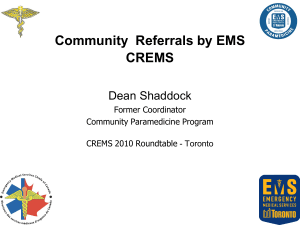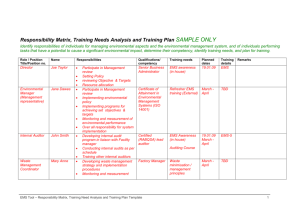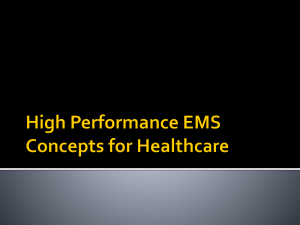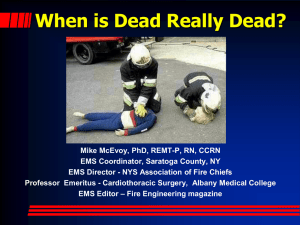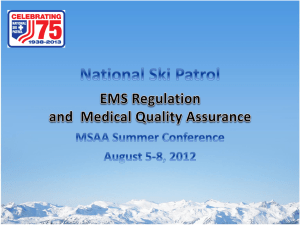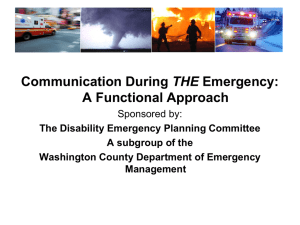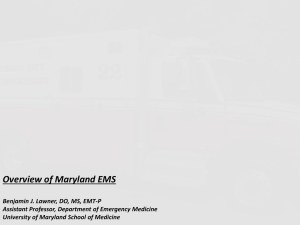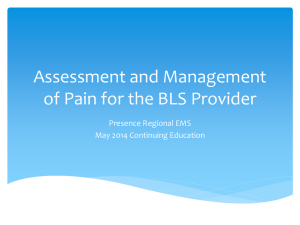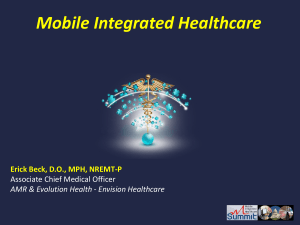EMS 101: History and Modern Realities
advertisement
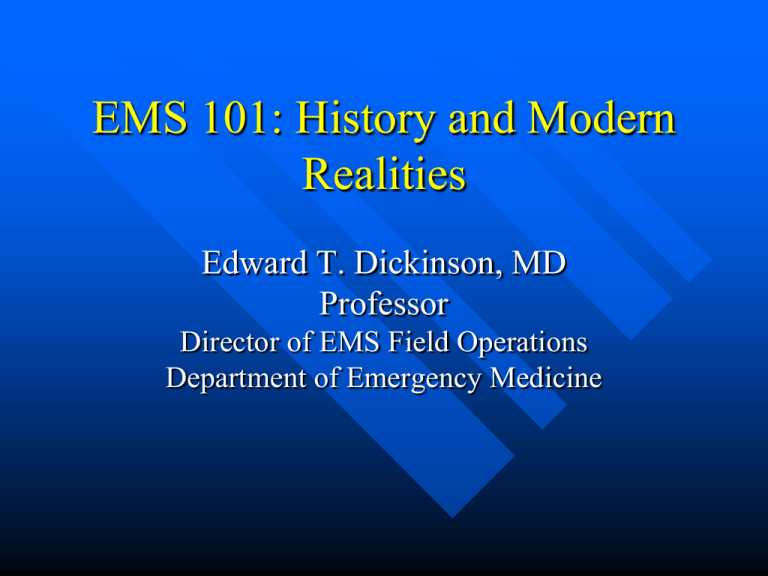
EMS 101: History and Modern Realities Edward T. Dickinson, MD Professor Director of EMS Field Operations Department of Emergency Medicine Lecture Overview EMS Basics EMS History EMS Personnel National Trends Local Realities EMS System Basics Enhanced 911 “E-911” Called ID – like function Name Phone Number Location Linked to computer assisted dispatch system – Previous location history History of EMS Military History Baron Larrey – Napoleon’s surgeon – “Ambulance volante” 1792 WW I - Mr. Thomas British surgeon - Developed the traction splint during the war to reduce mortality - Post war insight in the medical literature - Shock physiology - Time and speed of care recognized to reduce mortality Military History WW II – Fluid resuscitation, as blood and plasma are sent to all theaters (many die of renal failure later) Korean War – MASH – Helicopter evacuation Viet Nam – Trauma research in the field – “Golden hour” is born Military History Iraq and Afghanistan – Traumatic Brain Injury – Hallmark Injury due to IEDs – New paradigm of Federal funding for simultaneous civilian research Civilian History Civilian History 1947 Beck develops AC defibrillation 1958 Safar rediscovers CPR 1966 National Highway Safety Act 1967 Pantridge describes mobile ICUs A Mobile Intensive Care Unit in the Management of Myocardial Infarction The Lancet August 5, 1967 Pantridge and Geddes at the Royal Victoria Hospital in Belfast Fifteen month experience – 10 Cardiac Arrest out-of-hospital – All patients resuscitated – 5 Patients discharged “alive and well” Civilian History 1971 AAOS publishes Emergency Care and Transportation of the Sick and Injured 1973 Emergency Medical Services Act – Defined and funded the crucial 15 elements of EMS Systems EMS Personnel Curriculum set by the Federal Department of Transportation Scope of Practice set by each state Length of training minimums set by the DOT, but overseen by the states Certifications by the states with local credentialing Emergency Medical Dispatcher 24 Hours of training Utilization of medically driven card or CAD system Medical priority dispatch Provide “pre-arrival instructions” Emergency Medical Responder (Certified First Responder) First on scene Police, firefighters, etc 45 Hours of training CPR Automated external defibrillators (AEDs) Splinting and bleeding control “BLS” Emergency Medical Technician EMT- Basic 120 hours of training with 10 hours of ER observation All EMR skills Oxygen administration Basic extrication skills Assist with patients’ meds (NTG, MDI) CPAP, Epi-pens® BLS vs. ALS Basic Life Support – Emergency First Responders and EMTs – First Aid Level Skills – Oxygen – Basic assessment skills Advanced Life Support – Advanced EMTs and paramedics – Advanced assessment skills – More “doctor-like” interventions – Drugs, advanced airways, etc EMT - Intermediate EMT-B who goes on to advance training Hours vary by states (80 1000 hours) Additional assessment skills IV’s Some medications Advanced airway skills (ET, Combi-tube) ALS Provider EMT-Paramedic EMT-B training plus > 1000 hours of training. Clinical rotations in the ED, ICU, CCU, Labor & Delivery and anesthesia Field internship Strict continuing education requirements ALS provider EMT-Paramedic Advanced patient assessment skills Full ACLS and other drugs Endotracheal intubation Some surgical skills – Surgical airway – Chest decompression EKG interpretation – Monitor and 12 Lead EMS Personnel National “Board Certification” by the National Registry of Emergency Medical Technicians EMT-B, EMT-I, and EMT-P Written, oral and practical exams Requires CME to maintain EMS Physician Agency Medical Directors Base Command Physicians National Association of EMS Physicians New Subspecialty – 2013 First Exam – Fellowships – Practice Track Medical Oversight of EMS Paramedics and other advanced life support (ALS) providers practice under the delegated authority of physicians – Paramedics are generally certified not licensed – In PA, a physician Medical Director verifies a paramedic’s authority to provide care annually Medical Oversight of EMS Standing orders – – – – Previously agreed protocols Actions do not require on-line physician contact Specific limits set by protocol Examples: defibrillation, intubation, ACLS On-line Medical Direction, ie “Command” – Special procedures – Controlled substances Medical Oversight of EMS Prospective oversight – Involvement in training – Protocol development Real-time oversight – Field observation – On-line command – ED Feedback Medical Oversight of EMS QA/PI – Real-time feedback – Revision and development of protocols – Referral to the agency Medical Director Patient Destination Patient wishes Nearest hospital Triage to regional referral centers – Trauma center – Burn center – Hyperbarics National Trends and Issues Limited resources – Longer response times – Poor outcomes Shifting reimbursement structures Limited job advancement National Trends and Issues Difficult to advance quality and level of care given the current challenges RSI by paramedics Intubation by EMT-Basics Prehospital vs. Out-of-hospital care – Preventative health measures – Triage initiatives » San Francisco model National Trends and Issues Diversion due to ER overcrowding Expanding EMS Case Law High profile errors with large media exposure Does EMS make a difference in patient outcome? Regional Realities Suburban EMS – Loss of hospital based paramedic units – Transition to local “volunteer” fire departments responsible for advanced care Philadelphia Fire Rescue – Over-worked – Not fully cross trained and integrated as firefighters (2nd Class Citizen Syndrome) QUESTIONS ?

